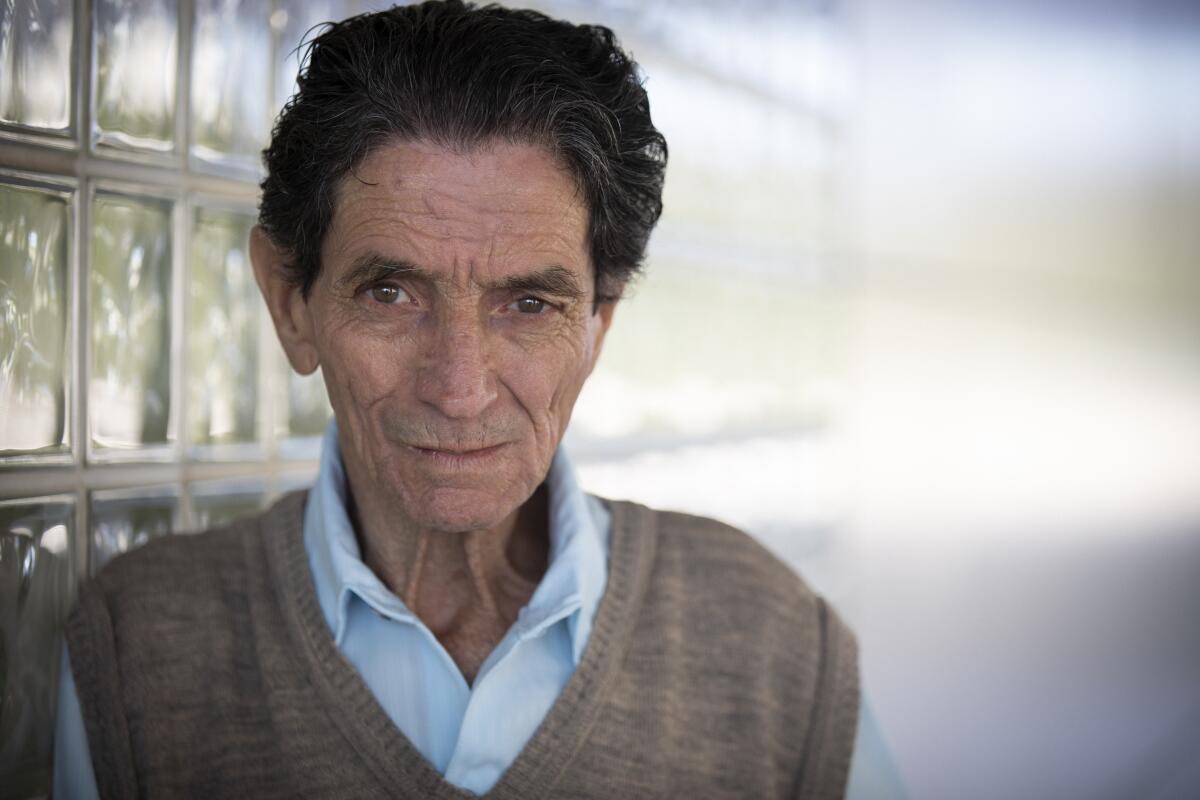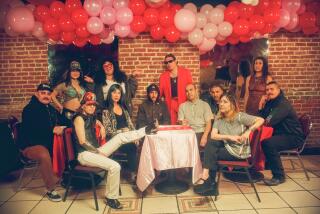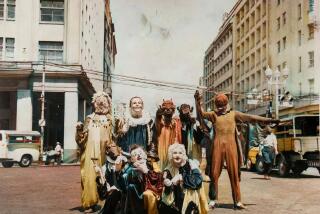Flavio da Silva, photographed as a boy in Brazil’s favelas, on the images that outraged
Gordon Parks’ 1961 images of favela dweller Flávio da Silva for Life magazine, on display at a current Getty exhibit, sparked a media spat between Brazil and the U.S. Da Silva tells The Times what the series meant to him
In the early 1960s, Gordon Parks accepted a Life magazine assignment for a special report about poverty in Latin America. The photographer, known for his stark images of struggle and magnetic portraits, was dispatched to Brazil, where his primary task was to record the daily life of a poor family in a Rio de Janeiro slum.
When he took the job, Parks couldn’t have possibly suspected that the assignment would indelibly mark the rest of his career. Nor could he have known that it would completely remake the life of his principal subject: Flávio da Silva, a rachitic 12-year-old boy who lived a life of grinding poverty in a favela named Catacomb — Catacumba in Portuguese. Certainly, neither could have imagined that their first brief encounter, on a path that led up a steep Rio hillside, would establish a connection that would last for decades, until Parks’ death in 2006.
“I see him, Gordon Parks — he makes part of the family,” Da Silva, now 70, says with affection in halting English. “Friendship, good friendship.”
For the assignment, Parks created a stark, black-and-white portfolio of images that showed Da Silva, the eldest of seven siblings, in daily acts of survival: hauling 40-pound tins of water up a mountain, tidying the family’s modest shack, feeding an infant sibling a plate of beans, contending with violent asthma attacks — all of which he faced with the stoicism of an adult.
“I am not afraid of death,” he told Parks in the story’s accompanying text in 1961. “But what will [my family] do after?”
The story, which debuted in the pages of Life in June of that year, generated empathy and outrage: empathy from the magazine’s U.S. readers, who rained donations for Da Silva on the offices of Life magazine; outrage in Brazil, where critics accused the magazine of wallowing in stereotypes about Latin America.
The indignation was such that the now-defunct Brazilian weekly O Cruzeiro sent a photographer to New York City to shoot a poor family there and record similar squalor.
This complex tale — one that addresses issues of agency and exploitation, politics and propaganda, and the relationship between journalist and subject — is at the heart of the new exhibition “Gordon Parks: The Flávio Story,” now on view at the Getty Museum in Los Angeles. The show (and its very worthwhile catalog) gathers images from Parks’ initial report, along with subsequent follow-ups, and displays these alongside the images taken by Henri Ballot in New York for O Cruzeiro.
The Getty also invited Da Silva, who lives in Rio de Janeiro, to come see the show that was drawn from his life.
Da Silva is a slender man with a full head of hair that shows only light traces of gray. He is exceedingly mild-mannered, but when he grins, his face seems illuminated by crackling electricity. It was Da Silva’s smile that caught Parks’ eye when they met in Catacumba.
Seated on a sunny terrace at the Getty, Da Silva says he had little understanding of the significance of Parks’ story at the time it was published. “I just hear that and see pictures,” he says. “But I don’t know how big the situation is.”
His parents were then eking out a subsistence living on $25 a month (about $215 today). Magazines were not a part of his everyday life. But appearing in Life magazine changed his in ways that have been remarkable, but also burdensome.
At a moment in which questions of power and representation in media are being fiercely debated, “The Flávio Story” is a show that couldn’t be more timely.
“This story is from 1961,” says Getty associate curator Amanda Maddox, who organized the exhibition with Paul Roth, director of the Ryerson Image Centre in Toronto. “It tells you that this issue of agency for a subject — the nature of the relationship between a photographer and subject — it has been complicated for a very long time.”
In the case of Parks and Da Silva, it was a relationship that was complicated further when Parks and Life magazine became part of the story.
That’s because the article landed like a lightning bolt. In the wake of its publication, Life received more than $26,000 in donations from readers who wanted to help (the equivalent of more than $223,000 in 2019). With the funds, the staff at the magazine bought a home for the Da Silva family, a modest concrete bungalow in a working-class neighborhood that represented a vast improvement over their shack in the favela. The magazine also arranged to transport the young Flávio to the United States for two years of free medical treatment.
In the month after the story ran, Parks flew to Brazil to meet with the family and secure permission to bring Da Silva to the U.S. — and from there, the whiplash began. In the course of a single day, the Da Silvas were relocated to their new home — a photo in the exhibition shows them peering through a window, dazed — and Flávio and Parks boarded a flight, bound for an asthma care center in Denver. An image taken by a Brazilian photographer, which serves as the cover of the catalog, shows a teary Da Silva clinging to Parks as they make their way through the airport.
The trip to Denver brought Da Silva needed medical treatment. In addition to asthma, he was malnourished and was suffering from infection. It also dropped him in a place where he didn’t speak the language or understand the culture.
“I miss my family,” he recalls of his early weeks there. “Sometimes I cry alone. You cannot imagine if they are good.”
If leaving Brazil was difficult, his return was even more so.
After two years, Da Silva had become acclimated to life in the U.S. A local host family, José and Kathy Gonçalves, had semi-adopted him. He played baseball with friends, developed a crush on a girl named Deborah and learned to speak English (which he maintains remarkably well). In a snapshot taken by the Gonçalves family on display at the Getty, Da Silva is seen in a dapper suit, jauntily posing with one foot on a car fender. He looks happy and healthy.
Of returning to Brazil, he says, “I didn’t feel so happy.”
His return meant confronting the poverty that his family still faced, as well as his limited educational and economic opportunities. Da Silva’s professional life has since consisted of a constellation of low-paid jobs: restaurant work, cleaning, construction, a stint as a security guard and the under-the-table gigs that are a staple of the Latin American informal economy. Being the star of Parks’ series changed his life — but only so much.
There are also the ways in which Da Silva’s story has been used as political fodder. First, by Life magazine, whose report on poverty in Latin America was motivated not by investigating inequity, but by the Cold War preoccupation that substandard living conditions could generate communists. (The cover line for the report on Brazil blared: “Shocking Poverty Spawns Reds.”)
And there was the response to that piece in the Brazilian media. Many journalists there chalked up Life’s report — and the stories that followed, including a Life cover story about Da Silva’s medical treatment in Denver — to U.S. paternalism and imperialism. Life magazine, wrote a journalist from the Brazilian daily O Dia, created “a false understanding” of the country’s social and economic problems. “In view of this problem which involves evident hidden intentions, our attitude can only be that of protest.”
O Cruzeiro accused Parks of staging his photographs. In turn, Time magazine (which, like Life, was owned by Time Inc.), accused O Cruzeiro of fictionalizing its New York images. This bickering took the spotlight away from the issue at hand, says curator Sergio Burgi, who helped organize “O Caso Flávio,” an exhibition that explored these competing media narratives at the Instituto Moreira Salles in Rio last year.
“Poverty, it never became the public discussion,” he says. “It became more of an issue about the construction of truth and fake news.”
Interestingly, in all of these media squabbles no one ever thought to hand Da Silva a camera and ask him to document his own reality. Those truths, perhaps, would have been too difficult to deny.
Parks was largely unruffled by the political debate.
“He didn’t really care what others felt,” says Peter Kunhardt Jr., executive director of the Gordon Parks Foundation, the New York-based organization that maintains the photographer’s archive. “He was doing something that helped Flávio and his family.”
Flávio da Silva was more than a story. In the decades after his first article ran, Parks and Da Silva maintained a lively written correspondence. The photographer returned to Brazil for visits in the 1970s and again in the 1990s. In 1978 he published “Flávio,” his memoir of the story.
In the book, Parks expresses doubts about the role he had in Da Silva’s life: “As a photojournalist I have on occasion done stories that have seriously altered human lives,” he writes. “In hindsight, I sometimes wonder if it might not have been wiser to have left those lives untouched.”
But his images have had a sticking power — and, on a regular basis, Da Silva is approached by journalists for his recollection of events.
“What was fascinating about this story is that it’s been retold so many times,” says Maddox. “Even now it’s being retold. And every time it was retold it was told slightly different. You never hear quite the same version repeated. That’s partly the product of time and memory. But I was compelled by the impulse to return to this story and retell it.”
Asked how he feels about continuously revisiting this moment of his life, Da Silva shrugs off the question.
“It’s God’s choice,” he says. “He made you the way you are. I am the way he wants me.”
The simple encounter that reverberates still? It was all just a matter of fate.

“Gordon Parks: The Flávio Story”
Where: Getty Museum, 1200 Getty Center Dr., Los Angeles
When: Through Nov. 10
Info: getty.edu
[email protected] | Twitter: @cmonstah
More to Read
The biggest entertainment stories
Get our big stories about Hollywood, film, television, music, arts, culture and more right in your inbox as soon as they publish.
You may occasionally receive promotional content from the Los Angeles Times.











